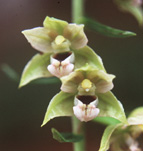Epipactis helleborine (L.) Crantz
Helleborine
The name Epipactis is apparently derived from a Greek name for the
genus Helloborus. The specific epithet helleborine is the
Latin meaning "like Helloborus." Both names are apparently due
to the similarity of the plants to those of Helloborus.

Photo courtesy of Dan Aussem
DESCRIPTION: Plant arising
from a fascicle of fibrous roots, 25-60 (-120) cm high; several stems may
arise from the same rootstock. Leaves 3-30, puberulent, ovate-lanceolate,
plicate, 3-15 cm long and 1.5-6 (-7) cm wide. Inflorescence a loosely
one-sided terminal raceme of 15-30 (-50) flowers, each subtended by a lanceolate
to lance-linear green foliaceous bract 2-6 cm long and 1-2 cm wide. Sepals
ovate-lanceolate, 1-1.5 cm long and 5-6 mm wide, green and often suffused
with pinkish-purple. Petals similar in size and appearance to the
sepals. Labellum 1-1.5 cm long and 4-8 mm wide, divided into two
portions by a central constriction. The part closest to the column (hypochile)
bowl-shaped, purplish-brown and frequently glossy inside, greenish outside.
The second part of the labellum (epichile) triangular, white, green or purplish,
with a fleshy callus near the point of attachment to the hypochile.
SIMILAR SPECIES: Epipactis is so unique that it could not be
confused with any other plant.
HABITAT: Epipactis grows in almost any habitat, but it is usually
found under a canopy of trees. In many ways it is a weed, and has even turned
up as a weed in gardens in Milwaukee. At The Ridges, in Door County, Epipactis
is beginning to aggressively invade undisturbed habitat. The managers have
taken steps to control this unusual weed.
FLOWERING DATES: July-August.
POLLINATION: In its native Europe, Epipactis is pollinated by
wasps (Nilsson 1978), but it is also autogamous (Reference).
DISCUSSION: Epipactis was first found in Milwaukee in 1930
in Lake Park (Fuller 1933). Most likely
it was planted somewhere in Milwaukee, as Epipactis was commonly
planted by members of garden clubs, etc. after its discovery in New York
in 1879. Since 1930 Epipactis has rapidly spread to the counties
neighboring Milwaukee, and is found north to Door county. In Door county
Epipactis has become very common and is an aggressive weed (see above).
WI DISTRIBUTION:  U.S. DISTRIBUTION:
U.S. DISTRIBUTION:
Go directly to Wisconsin herbarium records.
Return
to the main LIST of the Orchids of Wisconsin.
Return to the main KEY to the Orchids of
Wisconsin.

 U.S. DISTRIBUTION:
U.S. DISTRIBUTION: